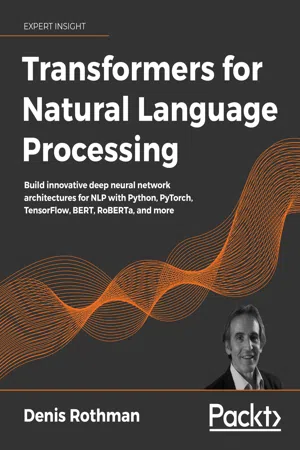
Transformers for Natural Language Processing
Build innovative deep neural network architectures for NLP with Python, PyTorch, TensorFlow, BERT, RoBERTa, and more
- 384 pages
- English
- ePUB (mobile friendly)
- Available on iOS & Android
Transformers for Natural Language Processing
Build innovative deep neural network architectures for NLP with Python, PyTorch, TensorFlow, BERT, RoBERTa, and more
About this book
Publisher's Note: A new edition of this book is out now that includes working with GPT-3 and comparing the results with other models. It includes even more use cases, such as casual language analysis and computer vision tasks, as well as an introduction to OpenAI's Codex.
Key Features
- Build and implement state-of-the-art language models, such as the original Transformer, BERT, T5, and GPT-2, using concepts that outperform classical deep learning models
- Go through hands-on applications in Python using Google Colaboratory Notebooks with nothing to install on a local machine
- Test transformer models on advanced use cases
Book Description
The transformer architecture has proved to be revolutionary in outperforming the classical RNN and CNN models in use today. With an apply-as-you-learn approach, Transformers for Natural Language Processing investigates in vast detail the deep learning for machine translations, speech-to-text, text-to-speech, language modeling, question answering, and many more NLP domains with transformers.
The book takes you through NLP with Python and examines various eminent models and datasets within the transformer architecture created by pioneers such as Google, Facebook, Microsoft, OpenAI, and Hugging Face.
The book trains you in three stages. The first stage introduces you to transformer architectures, starting with the original transformer, before moving on to RoBERTa, BERT, and DistilBERT models. You will discover training methods for smaller transformers that can outperform GPT-3 in some cases. In the second stage, you will apply transformers for Natural Language Understanding (NLU) and Natural Language Generation (NLG). Finally, the third stage will help you grasp advanced language understanding techniques such as optimizing social network datasets and fake news identification.
By the end of this NLP book, you will understand transformers from a cognitive science perspective and be proficient in applying pretrained transformer models by tech giants to various datasets.
What you will learn
- Use the latest pretrained transformer models
- Grasp the workings of the original Transformer, GPT-2, BERT, T5, and other transformer models
- Create language understanding Python programs using concepts that outperform classical deep learning models
- Use a variety of NLP platforms, including Hugging Face, Trax, and AllenNLP
- Apply Python, TensorFlow, and Keras programs to sentiment analysis, text summarization, speech recognition, machine translations, and more
- Measure the productivity of key transformers to define their scope, potential, and limits in production
Who this book is for
Since the book does not teach basic programming, you must be familiar with neural networks, Python, PyTorch, and TensorFlow in order to learn their implementation with Transformers.
Readers who can benefit the most from this book include experienced deep learning & NLP practitioners and data analysts & data scientists who want to process the increasing amounts of language-driven data.
Frequently asked questions
- Essential is ideal for learners and professionals who enjoy exploring a wide range of subjects. Access the Essential Library with 800,000+ trusted titles and best-sellers across business, personal growth, and the humanities. Includes unlimited reading time and Standard Read Aloud voice.
- Complete: Perfect for advanced learners and researchers needing full, unrestricted access. Unlock 1.4M+ books across hundreds of subjects, including academic and specialized titles. The Complete Plan also includes advanced features like Premium Read Aloud and Research Assistant.
Please note we cannot support devices running on iOS 13 and Android 7 or earlier. Learn more about using the app.
Information
1
Getting Started with the Model Architecture of the Transformer
- The background of the Transformer
- The architecture of the Transformer
- The Transformer's self-attention model
- The encoding and decoding stacks
- Input and output embedding
- Positional embedding
- Self-attention
- Multi-head attention
- Masked multi-attention
- Residual connections
- Normalization
- Feedforward network
- Output probabilities
The background of the Transformer

Table of contents
- Preface
- Getting Started with the Model Architecture of the Transformer
- Fine-Tuning BERT Models
- Pretraining a RoBERTa Model from Scratch
- Downstream NLP Tasks with Transformers
- Machine Translation with the Transformer
- Text Generation with OpenAI GPT-2 and GPT-3 Models
- Applying Transformers to Legal and Financial Documents for AI Text Summarization
- Matching Tokenizers and Datasets
- Semantic Role Labeling with BERT-Based Transformers
- Let Your Data Do the Talking: Story, Questions, and Answers
- Detecting Customer Emotions to Make Predictions
- Analyzing Fake News with Transformers
- Appendix: Answers to the Questions
- Other Books You May Enjoy
- Index